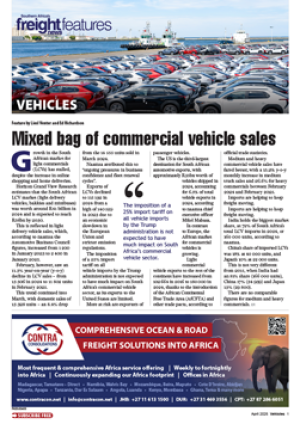CONSTRUCTION OF the country's two new car terminals at Durban and Port Elizabeth harbours has now begun - with a total investment for the two assessed at about R50- million.
Phase 1 at both projects is now underway.
In the case of Durban this is the demolition of the Cato Creek shed (on the Point Road quays, and just behind the Customs Building on the Embankment), some landing banks, and the lifting of some of the rail lines that are already there.
According to Ronnie Holtshausen, Portnet marketing manager in Durban, this will be finished in about two months.
All the capital invested, and the operation of the new terminal, is a Portnet responsibility.
But, said Holtshausen, the procedures are all being negotiated with all the stakeholders in the chain (especially the shipping lines and the motor car manufacturers). Our next meeting with NAAMSA (National Association of Automobile Manufacturers of SA), for example, is due for mid-March. The new Durban terminal - due for completion in the middle of next year - is designed to offer an annual transit capacity for 140 000 vehicle units The new terminal - due for completion in the middle of next year - is designed to offer an annual transit capacity for 140 000 vehicle units (with 56 000 expected to pass through it this year).
In Port Elizabeth, meantime, a similar demolition project is on-the-go, according to Claude Chidzero, business manager for bulk and breakbulk cargo.
Shed 1 - already condemned - is being pulled down to make way for the first part of the new car terminal development. This is being done as part of the general upgrading programme going-on at the port, according to Chidzero.
The land currently under Shed 1 and surrounding it is to be concrete-slabbed this financial year. It will be done at a higher specification than that required purely for the car terminal, he said. We are doing so with an eye to the future of this port - in reaction to the Coega Industrial Port developments. We see three possible phases leading to completion of Coega. The current one we regard as the coastal traffic phase. We need to gain hands-on experience before the major deep- sea avalanche of imports and exports scheduled for early- to mid-1998.
Thus, for now, we are looking to form closer relationships with users of rudimentary car terminals in the port - including Motorvia and Sea Deliveries. The second phase is from 1998 - when deep-sea motor car imports and exports are expected to increase substantially.
Customer demand, said Chidzero, will determine our move from being mere throughput terminals to being vehicle processing centres (VPCs) - where other value-adding services will be provided. The third phase is post-Coega.
Said Chidzero: Then the VPC concept will be brought into itself, through movement of the so-called dirty activities to Coega, leaving behind the clean activities - like container handling and motor car terminals. These will be properly arranged within the port, giving each the prominence it deserves. Of the more-than R20-million to be spent in PE on the terminal, some R3-m is earmarked this financial year to upgrade the area where the current motor car terminals are situated to deep-sea motor car operational specifications. In the next financial year, the rest of the R17-m will be sunk into the port to meet the needs of creating a purpose-built VPC terminal.
This is a vital project for PE, according to Kevin Wakeford, c.e.o. of the Chamber of Commerce & Industry.
With our coastal situation, he said, we naturally enjoy a transport cost advantage in exports compared to the inland areas. And the motor manufacturers here, at Uitenhage and East London are all very bullish about the export potential for CBUs (completely built-up units). We expect to be looking at traffic of these reaching a total of some 52 000 units a year by the turn of the century.
